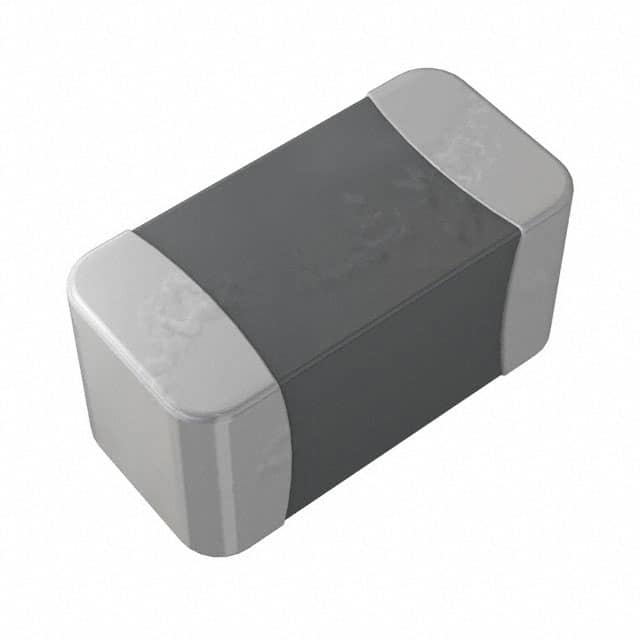NTCG164LH104JTDS
Product Overview
NTCG164LH104JTDS belongs to the category of NTC thermistors. These thermistors are commonly used for temperature sensing, control, and compensation in various electronic devices and systems. The NTCG164LH104JTDS thermistor is known for its high precision, reliability, and wide operating temperature range. It comes in a standard package and is available in bulk quantities.
Basic Information
- Category: NTC Thermistor
- Use: Temperature sensing, control, and compensation
- Characteristics: High precision, reliability, wide operating temperature range
- Package: Standard
- Essence: Temperature measurement and control
- Packaging/Quantity: Bulk quantities
Specifications
- Resistance Value: 100kΩ
- Tolerance: ±5%
- Operating Temperature Range: -40°C to 125°C
- Maximum Power Rating: 450mW
- Thermal Time Constant: 7s (in still air)
Detailed Pin Configuration
The NTCG164LH104JTDS thermistor has two leads with a standard pin configuration. The leads are typically labeled as "1" and "2," with lead "1" being the positive terminal and lead "2" being the negative terminal.
Functional Features
- Temperature Sensing: Accurately measures temperature changes.
- Control and Compensation: Used in circuits to control temperature or compensate for temperature variations.
- Reliability: Provides stable and reliable temperature measurements.
Advantages and Disadvantages
Advantages
- High precision temperature sensing
- Wide operating temperature range
- Reliable performance
Disadvantages
- Tolerance of ±5% may not be suitable for highly precise applications
- Limited power rating compared to some other thermistors
Working Principles
The NTCG164LH104JTDS operates based on the principle of negative temperature coefficient (NTC). As the temperature increases, the resistance of the thermistor decreases, allowing it to accurately sense and respond to temperature changes in its environment.
Detailed Application Field Plans
The NTCG164LH104JTDS thermistor finds extensive use in various applications, including: - Temperature monitoring and control in consumer electronics - Thermal management in automotive systems - Industrial process control and monitoring - Medical equipment for temperature measurement
Detailed and Complete Alternative Models
Some alternative models to NTCG164LH104JTDS include: - NTCG164LH103JTDS: Similar specifications with a slightly lower resistance value - NTCG164LH105JTDS: Similar specifications with a slightly higher resistance value - NTCG164LH104JTD: Similar specifications with a different tolerance level
In conclusion, the NTCG164LH104JTDS NTC thermistor offers high precision temperature sensing and control capabilities, making it suitable for a wide range of applications across various industries.
Word count: 411
Senaraikan 10 soalan dan jawapan biasa yang berkaitan dengan aplikasi NTCG164LH104JTDS dalam penyelesaian teknikal
What is the NTCG164LH104JTDS used for?
- The NTCG164LH104JTDS is a thermistor commonly used for temperature sensing and compensation in various technical solutions.
What is the temperature range of NTCG164LH104JTDS?
- The NTCG164LH104JTDS has a temperature range of -40°C to 125°C, making it suitable for a wide range of applications.
What is the resistance value of NTCG164LH104JTDS at room temperature?
- At room temperature (25°C), the NTCG164LH104JTDS has a resistance value of 100 kΩ.
How does NTCG164LH104JTDS behave with temperature changes?
- The NTCG164LH104JTDS is a negative temperature coefficient (NTC) thermistor, meaning its resistance decreases as the temperature increases.
Can NTCG164LH104JTDS be used for temperature compensation in electronic circuits?
- Yes, the NTCG164LH104JTDS is commonly used for temperature compensation in electronic circuits due to its predictable resistance-temperature characteristics.
What are the typical applications of NTCG164LH104JTDS in technical solutions?
- Typical applications include temperature sensing in automotive systems, battery management, industrial equipment, and consumer electronics.
Is NTCG164LH104JTDS suitable for high-temperature environments?
- No, the NTCG164LH104JTDS is not designed for high-temperature environments and may not perform reliably above its specified maximum temperature.
What is the accuracy of NTCG164LH104JTDS in temperature measurement?
- The NTCG164LH104JTDS offers good accuracy in temperature measurement, typically within a few degrees Celsius when properly calibrated.
Does NTCG164LH104JTDS require any special handling during assembly or soldering?
- It is recommended to follow the manufacturer's guidelines for proper handling and soldering techniques to ensure the reliability and performance of NTCG164LH104JTDS.
Are there any alternative thermistors that can be used in place of NTCG164LH104JTDS?
- Yes, there are alternative NTC thermistors available with similar characteristics, but it's important to consider the specific requirements of the application before selecting an alternative.


